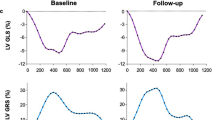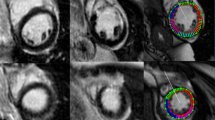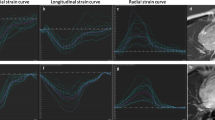Abstract
The purpose of this study is to test the capability of a commercially available feature tracking-cardiac magnetic resonance (FT-CMR) strain analysis software module in differentiating between viable and non-viable myocardium in chronic ischemic patients. Thirty chronic ischemic patients and 10 healthy volunteers were enrolled. Cine images were used for peak circumferential and radial strains quantification using dedicated FT-CMR software. Global strain was compared between patients and controls. In patients, segmental strain was compared in viable and non-viable myocardium determined by late gadolinium enhancement (LGE); and in segments with wall abnormalities. Among 480 myocardial segments analyzed in patients, 76 segments were non-viable on LGE. The mean left ventricular ejection fraction (LVEF) of the patients (87% males, mean age 55 ± 12 years) was 40 ± 12% vs. 61 ± 5% for the controls (80% males, mean age 39 ± 11 years). Peak global circumferential strain (GCS) and global radial strain (GRS) were significantly impaired in patients compared to controls (−13.89 ± 4.12% vs. −19.84 ± 1.47%), p < 0.001 and (23.11 ± 6.59% vs. 31.72 ± 5.52%), p = 0.001. Segmental circumferential strain (SCS) and segmental radial strain (SRS) were significantly impaired in non-viable compared to viable segments (-9.47 ± 7.26% vs. -14.72 ± 7.5%), p < 0.001 and (15.67 ± 12.11% vs. 24.51 ± 16.22%), p < 0.001. Cut-off points of -9.36% for the SCS (AUC = 0.7, 95% CI = 0.63–0.77) and 19.5% for the SRS (AUC = 0.67, 95%CI = 0.61–0.73) were attained above which the segment is considered viable.
SCS was able to discriminate between normokinetic, hypokinetic and akinetic segments (mean = 27.6 ± 17.13%, 18.66 ± 12.88% and 15.24 ± 10.70% respectively, p < 0.001). Circumferential and radial segmental strain analysis by FT-CMR was able to discriminate between viable and non-viable segments of the myocardium defined by LGE and between normokinetic, hypokinetic and akinetic segments, using routinely acquired cine images, and thus can provide a more objective metric for risk stratification in chronic ischemic patients.





Similar content being viewed by others
Data availability
Datasets are available upon request.
Abbreviations
- CABG:
-
Coronary artery bypass grafting
- CAD:
-
Coronary artery disease
- CCS:
-
Chronic coronary syndrome
- FT-CMR:
-
Feature tracking-cardiac magnetic resonance
- GCS:
-
Global circumferential strain
- GRS:
-
Global radial strain
- IHD:
-
Ischemic heart disease
- LGE:
-
Late gadolinium enhancement
- LV:
-
Left ventricle
- LVEF:
-
Left ventricular ejection fraction
- PCI:
-
Percutaneous coronary intervention
- RWMA:
-
Regional wall motion abnormality
- SCS:
-
Segmental circumferential strain
- SRS:
-
Segmental radial strain
- SSFP:
-
Steady-state free precession
- STE:
-
Speckle tracking echocardiography
References
WHO (2017) Available from https://www.who.int/news-room/fact-sheets/detail/cardiovascular-diseases-(cvds). Accessed Apr 2018
Knuuti J, Wijns W, Saraste A, Capodanno D, Barbato E, Funck-Brentano C et al (2019) 2019 ESC Guidelines for the diagnosis and management of chronic coronary syndromes. Eur Heart J 41(3):407–477
Roes SD, Mollema SA, Lamb HJ, van der Wall EE, de Roos A, Bax JJ (2009) Validation of echocardiographic two-dimensional speckle tracking longitudinal strain imaging for viability assessment in patients with chronic ischemic left ventricular dysfunction and comparison with contrast-enhanced magnetic resonance imaging. Am J Cardiol 104(3):312–317. https://doi.org/10.1016/j.amjcard.2009.03.040
Wu KC (2012) Myocardial viability imaging: dead or alive? J Am Coll Cardiol 59(9):836–837
Kim RJ, Wu E, Rafael A, Chen E-L, Parker MA, Simonetti O et al (2000) The use of contrast-enhanced magnetic resonance imaging to identify reversible myocardial dysfunction. N Engl J Med 343(20):1445–1453. https://doi.org/10.1056/NEJM200011163432003
Selvanayagam JB, Attila K, Francis JM, Wiesemann F, Petersen SE, Taggart DP et al (2004) Value of delayed-enhancement cardiovascular magnetic resonance imaging in predicting myocardial viability after surgical revascularization. Circulation 110(12):1535–1541. https://doi.org/10.1161/01.CIR.0000142045.22628.74
Ernst W, Adriana O, Christoph K, Michael G, Andreas W, Eckart F et al (2004) Magnetic resonance low-dose dobutamine test is superior to scar quantification for the prediction of functional recovery. Circulation 109(18):2172–2174. https://doi.org/10.1161/01.CIR.0000128862.34201.74
Schuster A, Hor KN, Kowallick JT, Beerbaum P, Kutty S (2016) Cardiovascular magnetic resonance myocardial feature tracking: concepts and clinical applications. Circ Cardiovasc Imaging 9(4):1–9
Rahman ZU, Sethi P, Murtaza G, Virk HUH, Rai A, Mahmod M et al (2017) Feature tracking cardiac magnetic resonance imaging: a review of a novel non-invasive cardiac imaging technique. World J Cardiol 9(4):312
Scatteia A, Baritussio A, Bucciarelli-Ducci C (2017) Strain imaging using cardiac magnetic resonance. Heart Fail Rev 22(4):465–476
Cerqueira MD, Weissman NJ, Dilsizian V, Jacobs AK, Kaul S, Laskey WK et al (2002) Standardized myocardial segmentation and nomenclature for tomographic imaging of the heart: a statement for healthcare professionals from the Cardiac Imaging Committee of the Council on Clinical Cardiology of the American Heart Association. J Nucl Cardiol 9(2):240–245
Maret E, Todt T, Brudin L, Nylander E, Swahn E, Ohlsson JL et al (2009) Functional measurements based on feature tracking of cine magnetic resonance images identify left ventricular segments with myocardial scar. Cardiovasc Ultrasound 7(1):1–14
Muser D, Castro SA, Santangeli P, Nucifora G (2018) Clinical applications of feature-tracking cardiac magnetic resonance imaging. World J Cardiol 10(11):210–221
Augustine D, Lewandowski AJ, Lazdam M, Rai A, Francis J, Myerson S et al (2013) Global and regional left ventricular myocardial deformation measures by magnetic resonance feature tracking in healthy volunteers: comparison with tagging and relevance of gender. J Cardiovasc Magn Reson 15(1):8
Taylor RJ, Moody WE, Umar F, Edwards NC, Taylor TJ, Stegemann B et al (2015) Myocardial strain measurement with feature-tracking cardiovascular magnetic resonance: normal values. Eur Heart J Cardiovasc Imaging 16(8):871–881
Morton G, Schuster A, Jogiya R, Kutty S, Beerbaum P, Nagel E (2012) Inter-study reproducibility of cardiovascular magnetic resonance myocardial feature tracking. J Cardiovasc Magn Reson 14(1):43. https://pubmed.ncbi.nlm.nih.gov/22721175
Taylor RJ, Umar F, Moody WE, Townend J, Steeds RP, Leyva F (2013) 102 The reproducibility and analysis time of cardiac magnetic resonance feature tracking: potential for clinical application. Heart 99(Suppl 2):A64 LP-A64. https://heart.bmj.com/content/99/suppl_2/A64.1.abstract
Kihlberg J, Haraldsson H, Sigfridsson A, Ebbers T, Engvall JE (2015) Clinical experience of strain imaging using DENSE for detecting infarcted cardiac segments. J Cardiovasc Magn Reson 17(1):1–9. https://doi.org/10.1186/s12968-015-0155-8
Khan JN, Singh A, Nazir SA, Kanagala P, Gershlick AH, McCann GP (2015) Comparison of cardiovascular magnetic resonance feature tracking and tagging for the assessment of left ventricular systolic strain in acute myocardial infarction. Eur J Radiol 84(5):840–848. https://doi.org/10.1016/j.ejrad.2015.02.002
Altiok E, Neizel M, Tiemann S, Krass V, Becker M, Zwicker C et al (2012) Layer-specific analysis of myocardial deformation for assessment of infarct transmurality: comparison of strain-encoded cardiovascular magnetic resonance with 2D speckle tracking echocardiography. Eur Hear J Cardiovasc Imaging 14(6):570–578. https://doi.org/10.1093/ehjci/jes229
Oyama-Manabe N, Ishimori N, Sugimori H, Van Cauteren M, Kudo K, Manabe O et al (2011) Identification and further differentiation of subendocardial and transmural myocardial infarction by fast strain-encoded (SENC) magnetic resonance imaging at 3.0 Tesla. Eur Radiol 21(11):2362–2368
Amaki M, Savino J, Ain DL, Sanz J, Pedrizzetti G, Kulkarni H et al (2014) Diagnostic concordance of echocardiography and cardiac magnetic resonance-based tissue tracking for differentiating constrictive pericarditis from restrictive cardiomyopathy. Circ Cardiovasc Imaging 7(5):819–827. https://doi.org/10.1161/CIRCIMAGING.114.002103
Onishi T, Saha SK, Delgado-Montero A, Ludwig DR, Onishi T, Schelbert EB et al (2015) Global longitudinal strain and global circumferential strain by speckle-tracking echocardiography and feature-tracking cardiac magnetic resonance imaging: comparison with left ventricular ejection fraction. J Am Soc Echocardiogr 28(5):587–596. https://doi.org/10.1016/j.echo.2014.11.018
Onishi T, Saha SK, Ludwig DR, Onishi T, Marek JJ, Cavalcante JL et al (2013) Feature tracking measurement of dyssynchrony from cardiovascular magnetic resonance cine acquisitions: comparison with echocardiographic speckle tracking. J Cardiovasc Magn Reson 15(1):95. https://doi.org/10.1186/1532-429X-15-95
Obokata M, Nagata Y, Wu VC-C, Kado Y, Kurabayashi M, Otsuji Y et al (2015) Direct comparison of cardiac magnetic resonance feature tracking and 2D/3D echocardiography speckle tracking for evaluation of global left ventricular strain. Eur Hear J Cardiovasc Imaging 17(5):525–532. https://doi.org/10.1093/ehjci/jev227
Becker M, Hoffmann R, Kühl HP, Grawe H, Katoh M, Kramann R et al (2006) Analysis of myocardial deformation based on ultrasonic pixel tracking to determine transmurality in chronic myocardial infarction. Eur Heart J 27(21):2560–2566. https://doi.org/10.1093/eurheartj/ehl288
Becker M, Lenzen A, Ocklenburg C, Stempel K, Kühl H, Neizel M et al (2008) Myocardial deformation imaging based on ultrasonic pixel tracking to identify reversible myocardial dysfunction. J Am Coll Cardiol 51(15):1473–1481. https://www.sciencedirect.com/science/article/pii/S0735109708003525
Chan J, Hanekom L, Wong C, Leano R, Cho GY, Marwick TH (2006) Differentiation of subendocardial and transmural infarction using two-dimensional strain rate imaging to assess short-axis and long-axis myocardial function. J Am Coll Cardiol 48(10):2026–2033
Tarascio M, Leo LA, Klersy C, Murzilli R, Moccetti T, Faletra FF (2017) Speckle-tracking layer-specific analysis of myocardial deformation and evaluation of scar transmurality in chronic ischemic heart disease. J Am Soc Echocardiogr 30(7):667–675. https://doi.org/10.1016/j.echo.2017.03.015
Acknowledgements
The authors would like to thank Dr. Soha Romeih, Dr. Mahmoud Shaaban, Dr. Dina Osama, Dr. Ahmed Kharabish, Dr. Dina Haroun and Dr. Fatma El Kafrawy for their contribution.
Funding
This study was not supported by internal or external funding.
Author information
Authors and Affiliations
Contributions
All authors contributed to the study conception and design. Material preparation, data collection and analysis were performed by ST and WEM. The first draft of the manuscript was written by ST and all authors commented on previous versions of the manuscript. All authors read and approved the final manuscript.
Corresponding author
Ethics declarations
Conflicts of interest
Nothing to disclose.
Code availability
Not applicable.
Consent to participate and for publication
Was obtained from all participants.
Ethical approval
The study was conducted according to the stipulations of the Ain Shams University (ASU) Ethical and Scientific Committee, keeping the privacy of participants and confidentiality of data, in accordance with the ethical standards laid down in the 1964 Declaration of Helsinki and its later amendments.
Informed consent
Written informed consent was read and signed by the patient himself or his/her relative.
Additional information
Publisher's Note
Springer Nature remains neutral with regard to jurisdictional claims in published maps and institutional affiliations.
Rights and permissions
About this article
Cite this article
Tantawy, S.W., Mohammad, S.A., Osman, A.M. et al. Strain analysis using feature tracking cardiac magnetic resonance (FT-CMR) in the assessment of myocardial viability in chronic ischemic patients. Int J Cardiovasc Imaging 37, 587–596 (2021). https://doi.org/10.1007/s10554-020-02018-w
Received:
Accepted:
Published:
Issue Date:
DOI: https://doi.org/10.1007/s10554-020-02018-w




